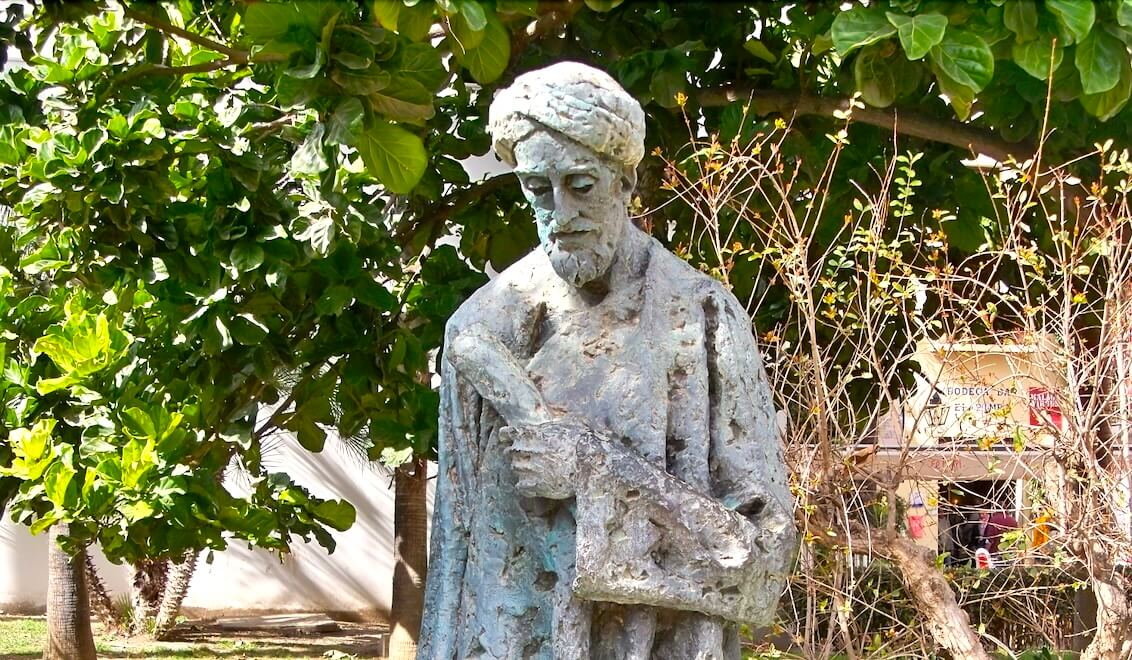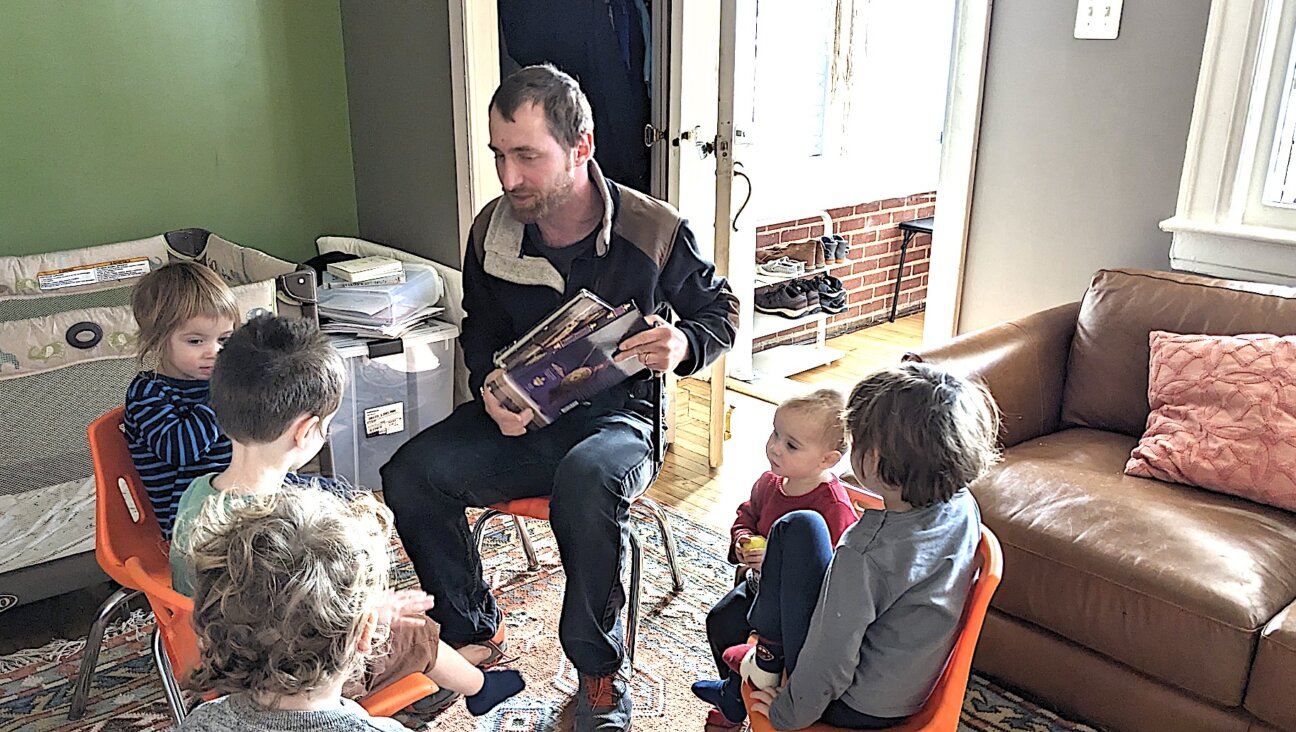Budapest Ghetto Gets Facelift
The newest nightspot in Budapest opened its doors Sunday night on Kiraly Street in the heart of what used to be this city’s Jewish ghetto. The three-level bar hosted a Hebrew rapper in the theater space downstairs, paintings by a young Hungarian Jew dotted the second-floor gallery, and on the front door was a mezuza with a playful cartoon of a little girl.
For many decades, through the Holocaust and communist rule, the streets of the ghetto were largely flushed of any Jewish presence. Today, however, the tide of history is turning, and a leading indicator is the new bar, known as Siraly, or Seagull, which had its grand opening on the night before the 50th anniversary of the Hungarian Uprising. Started by a group of Jewish friends, Siraly aims to be a showcase for hip Jewish culture.
During the past few years, the abandoned buildings of the seventh district have been revitalized by a number of new bars created by young Jewish men returning to the former stomping grounds of their ancestors — a historically Jewish area turned by the Nazis into a Jewish ghetto. Most of these bars carry no outward sign of being Jewish but have become known for their young Jewish clientele — a sampling from Budapest’s 100,000-person Jewish community. Siraly, with its Jewish programming and mezuza, is making explicit what has been implicit with the success of those other bars: The seventh district is becoming Jewish again, but on very new terms.
“This is all brand new — we are in the middle of some process,” said Adam Schoenberger, a 26 year old who founded Siraly with his friends, each of whom is responsible for one element of the three-story complex.
Schoenberger, who is also in a band that plays a mixture of hip hop, reggae and Jewish folk music, said: “We want to create an open environment where nobody has to be a member of something, or show a certificate of their Jewish roots. We want to show the Jewish culture.”
The work that Siraly is doing grows out of a number of different institutions in the neighborhood. There is Spinoza, a dinner club a few blocks away, where a sophisticated older crowd goes for readings and lectures. Around the corner from Spinoza, the Carmel Pince restaurant trumpets its secular credentials with a sign that says “Not Kosher” in Hebrew.
But it is the seventh district bars that were the most direct inspiration for Siraly. Schoenberger got his event-planning experience putting together Hanukkah parties and Jewish literary readings for nightspots like Szoda and Kuplung, which were founded by young Budapest Jews who came back to the city after living for a few years in Israel. A few blocks from each of those joints is an Israeli hummus bar that is known as the best in the city.
The connection between the seventh district’s past and present is rarely on display, but Siraly makes the link with a show of black-and-white photos taken a century ago when Kiraly Street was the main thoroughfare for Jewish peddlers. Hebrew-lettered signs hang over tiny stalls in scenes that recall Manhattan’s Lower East Side in its crowded immigrant heyday.
If the recent development of the seventh district has any precedent, it might, in fact, be the Lower East Side of today, where young Jews are returning to the tenements of their ancestors and going out to party in bars that play on the Hebrew signs and synagogues of the neighborhood. But Budapest’s development is also informed by a history that is very unlike that of New York.
Budapest has long been one of the largest Jewish cities in Europe. It earned the moniker of Judapest from Vienna’s antisemitic mayor in the late 19th century. During the Holocaust, Budapest’s Jewish community suffered fewer losses than surrounding areas due to the vagaries of Hungary’s complicity with the Nazis. When the Soviets liberated Hungary, there were almost 100,000 Jews in the Budapest ghetto.
After the Holocaust, the majority of the population chose to stay in Budapest. And while Judaism was not encouraged under communism, it was given more space to grow than in any other Eastern bloc country. Budapest had the only rabbinical seminary behind the Iron Curtain, as well as the only matzo factory. When the communist era ended, locals say there was a palpable excitement about Judaism and a proliferation of Jewish youth groups, day schools and summer camps.
“What you have had in Budapest is the critical mass of people to allow for things to happen,” said Ed Serotta, founder of a Jewish cultural project Centropa. The project has offices in Budapest and in other cities in the region.
“It first developed traditional community, and then in the last few years there has been this new definition of what a community is — that has rocketed out of control into places that no one knows how to chart,” Serotta said.
One of the neighborhood revelers is Peter Radvánszki, a tall, Jewish 26-year-old who says he spends a few nights a week at the bars in the seventh district, after which he frequently allows himself long, nostalgic walks home.
“I feel that if I turn one corner, I will see an Orthodox man with his hat and sidelocks,” Radvánszki said. “The whole area has a kind of mystical atmosphere. The only thing that continues this are we who are going out here every night. It’s we who are continuing the tradition.”
Radvánszki is involved in Budapest’s Reform synagogue, but he says that the small numbers going to synagogue pale in comparison to those meeting their Jewish friends at bars such as Kuplung, a cavernous industrial place a few doors down from Siraly where an enormous plaster cast of a whale hangs from the ceiling.
“This is the real success of Jewish Budapest,” Radvánszki said. “Now the Jewish life here is not just about going to synagogue; it’s about parties and going out.”
The new culture is still heavily marked by the communist experience, when most Jews were discouraged from speaking about their identity and Judaism was demonized. Some of that fear and anxiety remains, and many say that young people are still hesitant to enter places such as synagogues or Jewish community centers. In this atmosphere, the nightlife provides an easy, no-commitment alternative.
“Many people who know that they are somehow Jewish would deny it at any cost because of the history here,” said Zsuzsa Fritz, who runs Budapest’s Balint Jewish Community Center. “I know there are people I can never bring into the JCC. Until five years ago, those people had nowhere to go. Now they do.”
The development of such friendly Jewish spaces is not only a physical phenomenon — it is also happening in such virtual forums as the blog Judapest.org, which attracts anywhere from 300 to 500 visitors each day. The blog has 12 contributors, providing a mix of Jewish cultural tidbits in an irreverent voice that might remind Americans of the magazine Heeb.
Bruno Bitter, who, due to the secularism of the communist state, had no contact with Jewish life until his teenage years, founded Judapest two years ago. Sitting in his Budapest apartment, under an Andy Warhol print, Bitter said that he started Judapest in order to give young Hungarian Jews a different picture of Jewish identity than the one put forward by the official Jewish institutions in Hungary, which he described as “quite dusty.”
“Jews here are maybe used to being smart, but coolness and fun were not something attached to the notion of being Jewish,” said Bitter, who has a day job as a marketing researcher. “With this blog, we put all these new subjects out there. We said this is also our Jewish identity.”
The substance of this new culture has its critics. Gábor Szántó, the 40-year-old editor of Hungary’s most respected Jewish magazine, Szombat, enjoys hanging out at the bars of the seventh district but fears that the area provides only a superficial connection to Jewish culture.
“It’s a new kind of culture,” Szántó said. “It’s Internet culture — having fun together, listening to music. If it is the salt, that is okay. But if that is the entire meal, it’s a problem.”
At the existing bars, the Jewish owners are quick to downplay the Jewish element. The ceiling of Szoda is wallpapered with Japanese Manga comics. Szoda’s co-owner, Peter Stern, said that his goal was to make a bar not for Jews but where everyone can feel comfortable. But, Stern admitted, “we wanted to make a bar which is for our taste, and our taste is somehow a Jewish taste.”
Like many people, Stern grasps at the exact nature of that Jewish taste. He is not religious, and so the bar remains open on Friday nights. Stern points to a certain “intellectualism” and to a “love and peace in the air,” as well as to the parties they have had on Jewish holidays. But perhaps the most convincing trait is the bar’s work on Christmas Eve. While most other Budapest bars close for the night, Szoda stays open and has a Christmas party, at which, Stern estimates, 80% of the attendees are Jewish.
Schoenberger, the Siraly founder, thinks that Budapest Jews are ready for a more consciously Jewish element in their socializing. The second floor of Siraly will have a Jewish library along with the offices of Marom, a Conservative movement youth organization that Schoenberger helps to run. Plans are also afoot to start a Jewish record label that will sell albums out of Siraly.
“The first issue is to create references for Jews and non-Jews to think about what it means to be Jewish,” Schoenberger said. “This is an experiment, of course, no one knows how people will react.”
On one of Siraly’s first nights open, one of the guests was a Budapest-raised woman who came to see Jewish friends after returning from Israel a few weeks earlier.
“It’s like a little Jewish ghetto, but not in a bad way,” said Vivian Nobl, who is 30.
Nobl said that what defines the area for her is “not only the people. It’s a way of thinking. An openness.”
















